Communicable Disease Control Plan for Boarding Schools
VerifiedAdded on 2023/06/03
|16
|3976
|365
AI Summary
This plan aims to respond to the crisis of measles outbreak in boarding schools. It identifies prevention strategies, outbreak identification and response, and the role of stakeholders in the control, prevention, and treatment of measles.
Contribute Materials
Your contribution can guide someone’s learning journey. Share your
documents today.
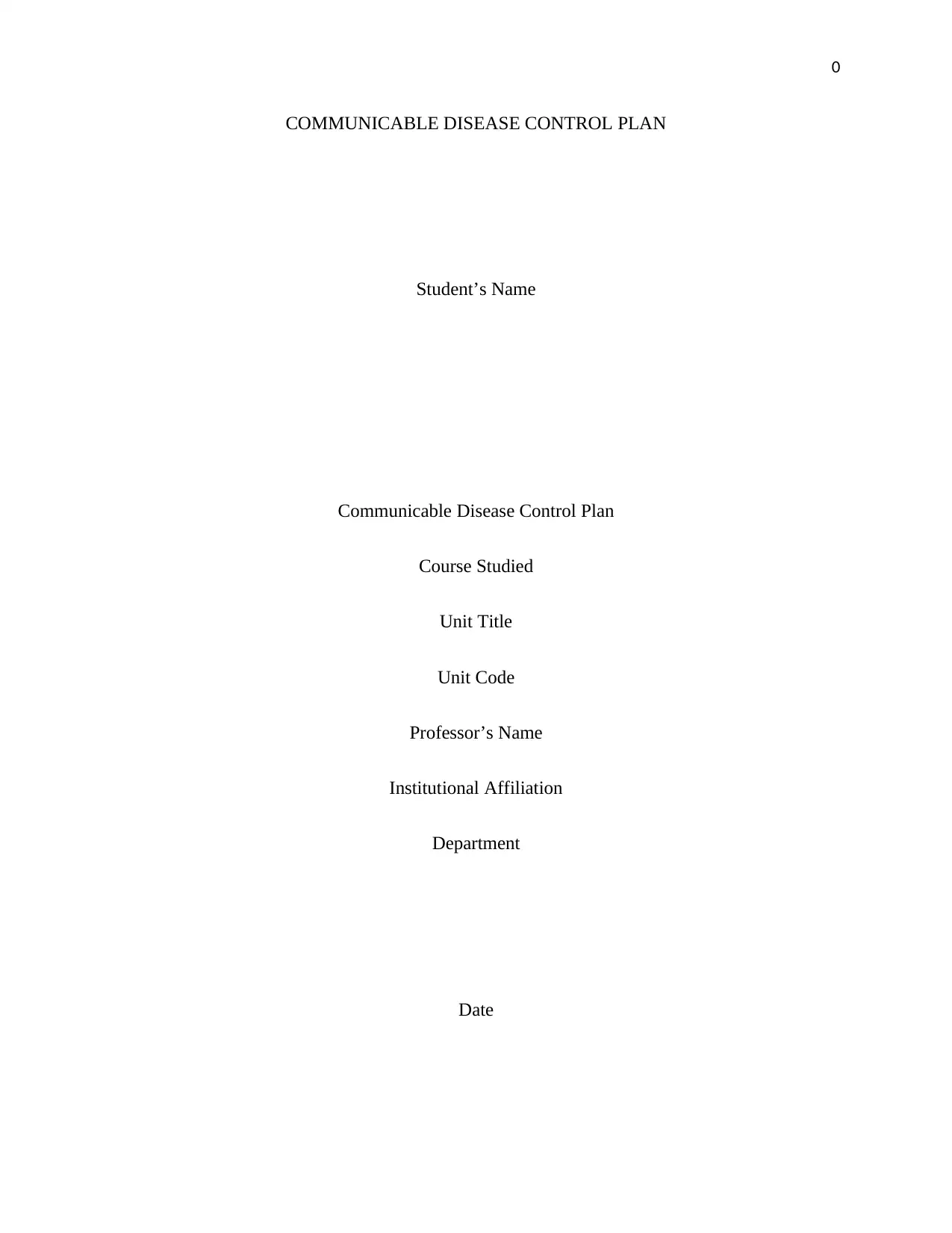
0
COMMUNICABLE DISEASE CONTROL PLAN
Student’s Name
Communicable Disease Control Plan
Course Studied
Unit Title
Unit Code
Professor’s Name
Institutional Affiliation
Department
Date
COMMUNICABLE DISEASE CONTROL PLAN
Student’s Name
Communicable Disease Control Plan
Course Studied
Unit Title
Unit Code
Professor’s Name
Institutional Affiliation
Department
Date
Secure Best Marks with AI Grader
Need help grading? Try our AI Grader for instant feedback on your assignments.
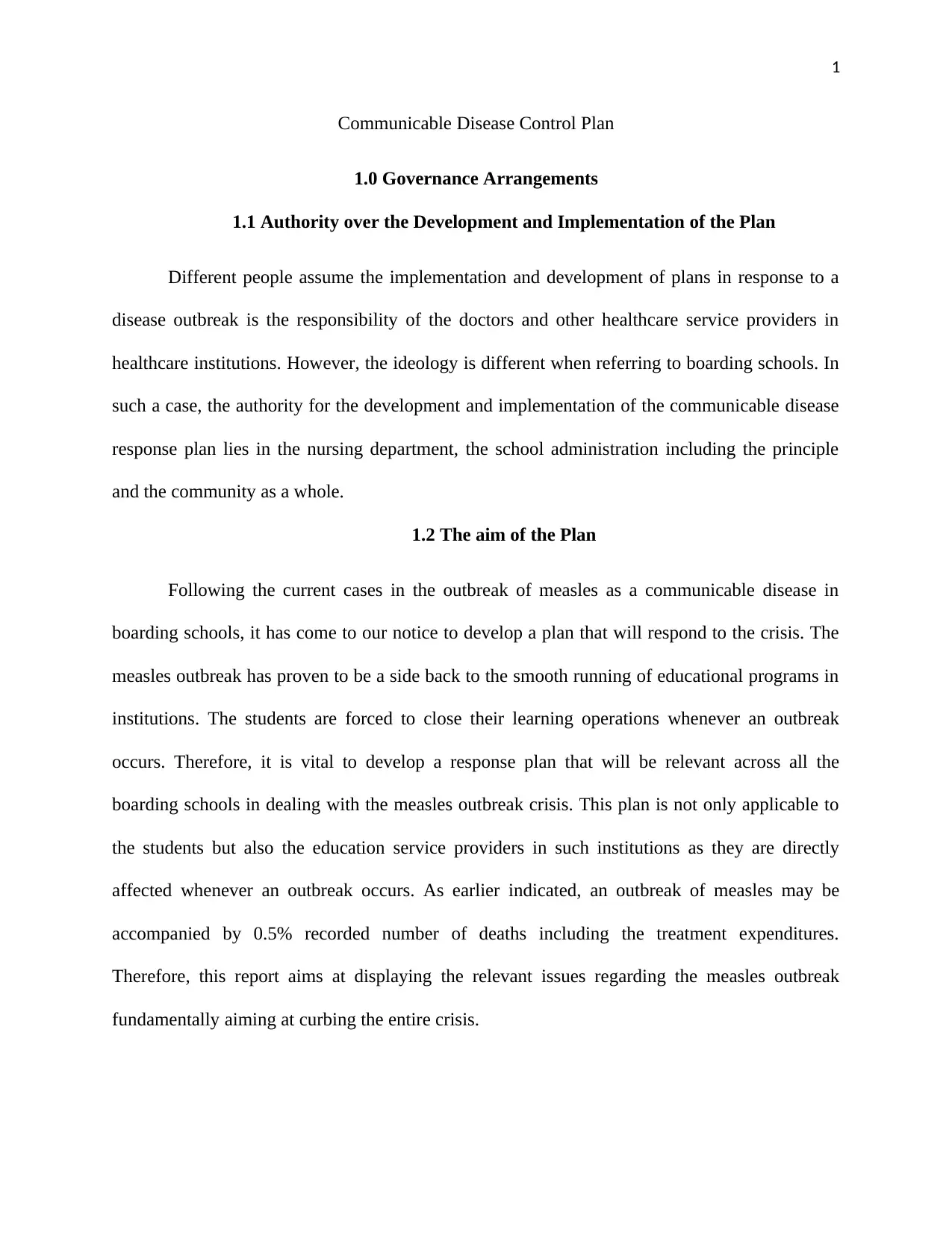
1
Communicable Disease Control Plan
1.0 Governance Arrangements
1.1 Authority over the Development and Implementation of the Plan
Different people assume the implementation and development of plans in response to a
disease outbreak is the responsibility of the doctors and other healthcare service providers in
healthcare institutions. However, the ideology is different when referring to boarding schools. In
such a case, the authority for the development and implementation of the communicable disease
response plan lies in the nursing department, the school administration including the principle
and the community as a whole.
1.2 The aim of the Plan
Following the current cases in the outbreak of measles as a communicable disease in
boarding schools, it has come to our notice to develop a plan that will respond to the crisis. The
measles outbreak has proven to be a side back to the smooth running of educational programs in
institutions. The students are forced to close their learning operations whenever an outbreak
occurs. Therefore, it is vital to develop a response plan that will be relevant across all the
boarding schools in dealing with the measles outbreak crisis. This plan is not only applicable to
the students but also the education service providers in such institutions as they are directly
affected whenever an outbreak occurs. As earlier indicated, an outbreak of measles may be
accompanied by 0.5% recorded number of deaths including the treatment expenditures.
Therefore, this report aims at displaying the relevant issues regarding the measles outbreak
fundamentally aiming at curbing the entire crisis.
Communicable Disease Control Plan
1.0 Governance Arrangements
1.1 Authority over the Development and Implementation of the Plan
Different people assume the implementation and development of plans in response to a
disease outbreak is the responsibility of the doctors and other healthcare service providers in
healthcare institutions. However, the ideology is different when referring to boarding schools. In
such a case, the authority for the development and implementation of the communicable disease
response plan lies in the nursing department, the school administration including the principle
and the community as a whole.
1.2 The aim of the Plan
Following the current cases in the outbreak of measles as a communicable disease in
boarding schools, it has come to our notice to develop a plan that will respond to the crisis. The
measles outbreak has proven to be a side back to the smooth running of educational programs in
institutions. The students are forced to close their learning operations whenever an outbreak
occurs. Therefore, it is vital to develop a response plan that will be relevant across all the
boarding schools in dealing with the measles outbreak crisis. This plan is not only applicable to
the students but also the education service providers in such institutions as they are directly
affected whenever an outbreak occurs. As earlier indicated, an outbreak of measles may be
accompanied by 0.5% recorded number of deaths including the treatment expenditures.
Therefore, this report aims at displaying the relevant issues regarding the measles outbreak
fundamentally aiming at curbing the entire crisis.
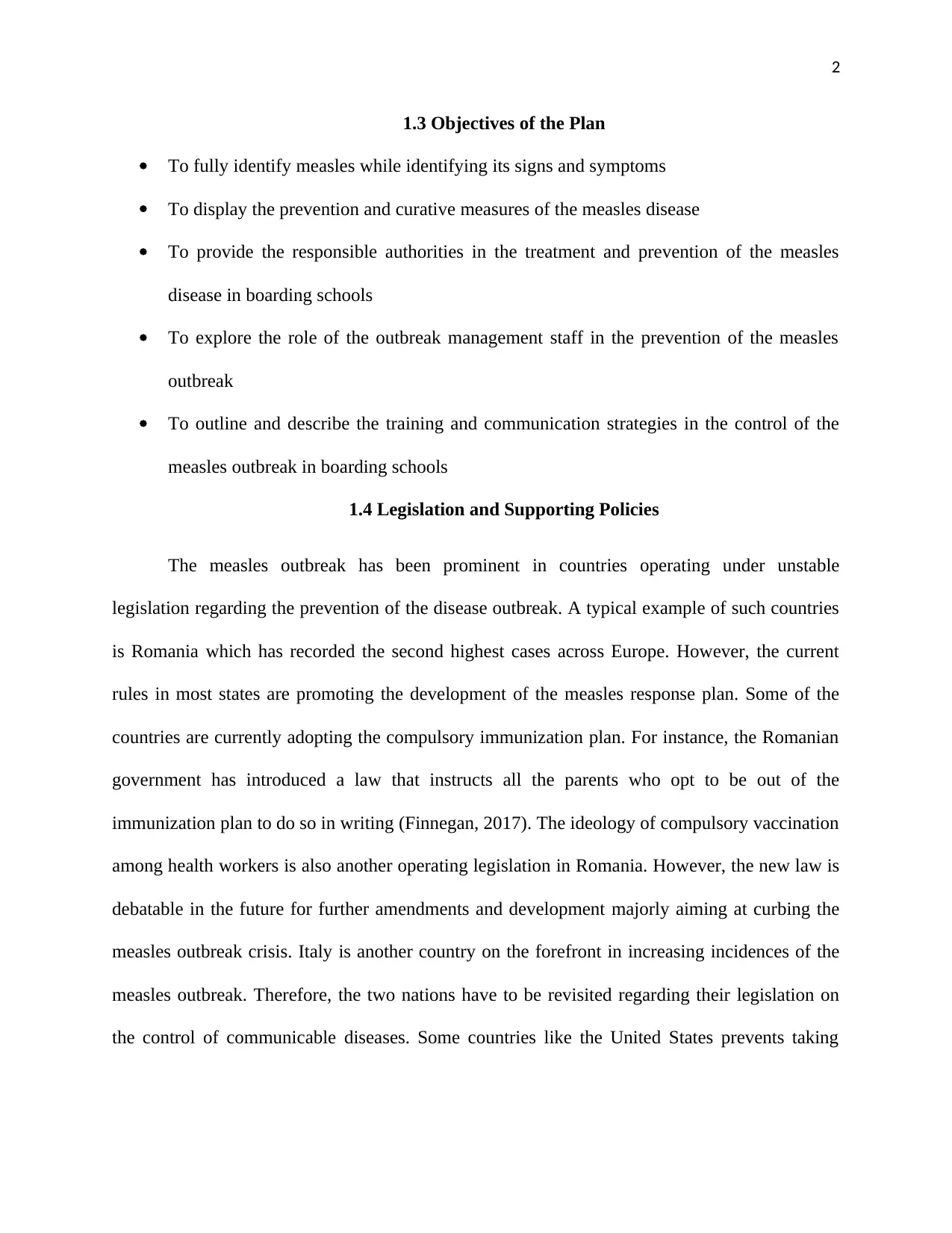
2
1.3 Objectives of the Plan
To fully identify measles while identifying its signs and symptoms
To display the prevention and curative measures of the measles disease
To provide the responsible authorities in the treatment and prevention of the measles
disease in boarding schools
To explore the role of the outbreak management staff in the prevention of the measles
outbreak
To outline and describe the training and communication strategies in the control of the
measles outbreak in boarding schools
1.4 Legislation and Supporting Policies
The measles outbreak has been prominent in countries operating under unstable
legislation regarding the prevention of the disease outbreak. A typical example of such countries
is Romania which has recorded the second highest cases across Europe. However, the current
rules in most states are promoting the development of the measles response plan. Some of the
countries are currently adopting the compulsory immunization plan. For instance, the Romanian
government has introduced a law that instructs all the parents who opt to be out of the
immunization plan to do so in writing (Finnegan, 2017). The ideology of compulsory vaccination
among health workers is also another operating legislation in Romania. However, the new law is
debatable in the future for further amendments and development majorly aiming at curbing the
measles outbreak crisis. Italy is another country on the forefront in increasing incidences of the
measles outbreak. Therefore, the two nations have to be revisited regarding their legislation on
the control of communicable diseases. Some countries like the United States prevents taking
1.3 Objectives of the Plan
To fully identify measles while identifying its signs and symptoms
To display the prevention and curative measures of the measles disease
To provide the responsible authorities in the treatment and prevention of the measles
disease in boarding schools
To explore the role of the outbreak management staff in the prevention of the measles
outbreak
To outline and describe the training and communication strategies in the control of the
measles outbreak in boarding schools
1.4 Legislation and Supporting Policies
The measles outbreak has been prominent in countries operating under unstable
legislation regarding the prevention of the disease outbreak. A typical example of such countries
is Romania which has recorded the second highest cases across Europe. However, the current
rules in most states are promoting the development of the measles response plan. Some of the
countries are currently adopting the compulsory immunization plan. For instance, the Romanian
government has introduced a law that instructs all the parents who opt to be out of the
immunization plan to do so in writing (Finnegan, 2017). The ideology of compulsory vaccination
among health workers is also another operating legislation in Romania. However, the new law is
debatable in the future for further amendments and development majorly aiming at curbing the
measles outbreak crisis. Italy is another country on the forefront in increasing incidences of the
measles outbreak. Therefore, the two nations have to be revisited regarding their legislation on
the control of communicable diseases. Some countries like the United States prevents taking
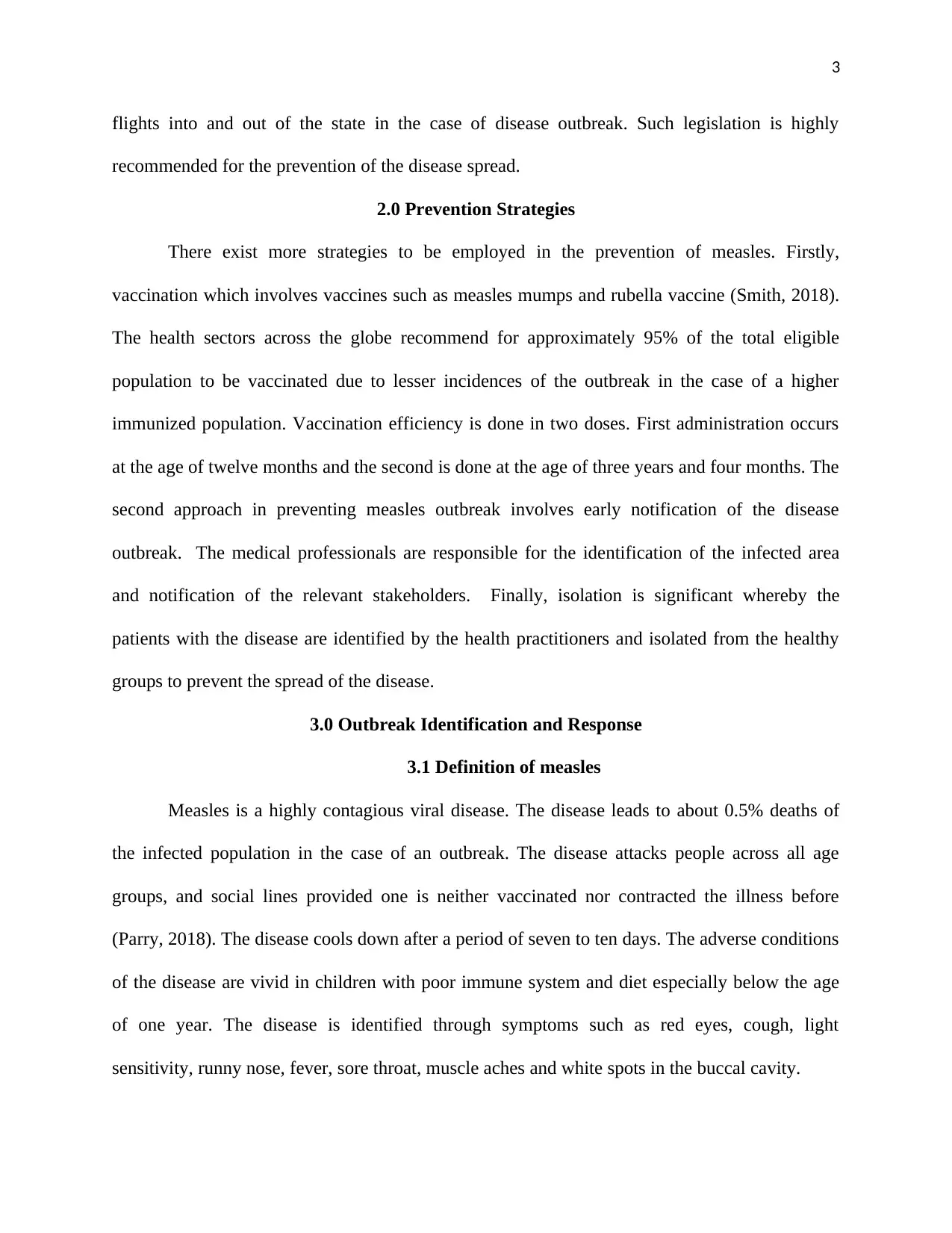
3
flights into and out of the state in the case of disease outbreak. Such legislation is highly
recommended for the prevention of the disease spread.
2.0 Prevention Strategies
There exist more strategies to be employed in the prevention of measles. Firstly,
vaccination which involves vaccines such as measles mumps and rubella vaccine (Smith, 2018).
The health sectors across the globe recommend for approximately 95% of the total eligible
population to be vaccinated due to lesser incidences of the outbreak in the case of a higher
immunized population. Vaccination efficiency is done in two doses. First administration occurs
at the age of twelve months and the second is done at the age of three years and four months. The
second approach in preventing measles outbreak involves early notification of the disease
outbreak. The medical professionals are responsible for the identification of the infected area
and notification of the relevant stakeholders. Finally, isolation is significant whereby the
patients with the disease are identified by the health practitioners and isolated from the healthy
groups to prevent the spread of the disease.
3.0 Outbreak Identification and Response
3.1 Definition of measles
Measles is a highly contagious viral disease. The disease leads to about 0.5% deaths of
the infected population in the case of an outbreak. The disease attacks people across all age
groups, and social lines provided one is neither vaccinated nor contracted the illness before
(Parry, 2018). The disease cools down after a period of seven to ten days. The adverse conditions
of the disease are vivid in children with poor immune system and diet especially below the age
of one year. The disease is identified through symptoms such as red eyes, cough, light
sensitivity, runny nose, fever, sore throat, muscle aches and white spots in the buccal cavity.
flights into and out of the state in the case of disease outbreak. Such legislation is highly
recommended for the prevention of the disease spread.
2.0 Prevention Strategies
There exist more strategies to be employed in the prevention of measles. Firstly,
vaccination which involves vaccines such as measles mumps and rubella vaccine (Smith, 2018).
The health sectors across the globe recommend for approximately 95% of the total eligible
population to be vaccinated due to lesser incidences of the outbreak in the case of a higher
immunized population. Vaccination efficiency is done in two doses. First administration occurs
at the age of twelve months and the second is done at the age of three years and four months. The
second approach in preventing measles outbreak involves early notification of the disease
outbreak. The medical professionals are responsible for the identification of the infected area
and notification of the relevant stakeholders. Finally, isolation is significant whereby the
patients with the disease are identified by the health practitioners and isolated from the healthy
groups to prevent the spread of the disease.
3.0 Outbreak Identification and Response
3.1 Definition of measles
Measles is a highly contagious viral disease. The disease leads to about 0.5% deaths of
the infected population in the case of an outbreak. The disease attacks people across all age
groups, and social lines provided one is neither vaccinated nor contracted the illness before
(Parry, 2018). The disease cools down after a period of seven to ten days. The adverse conditions
of the disease are vivid in children with poor immune system and diet especially below the age
of one year. The disease is identified through symptoms such as red eyes, cough, light
sensitivity, runny nose, fever, sore throat, muscle aches and white spots in the buccal cavity.
Secure Best Marks with AI Grader
Need help grading? Try our AI Grader for instant feedback on your assignments.
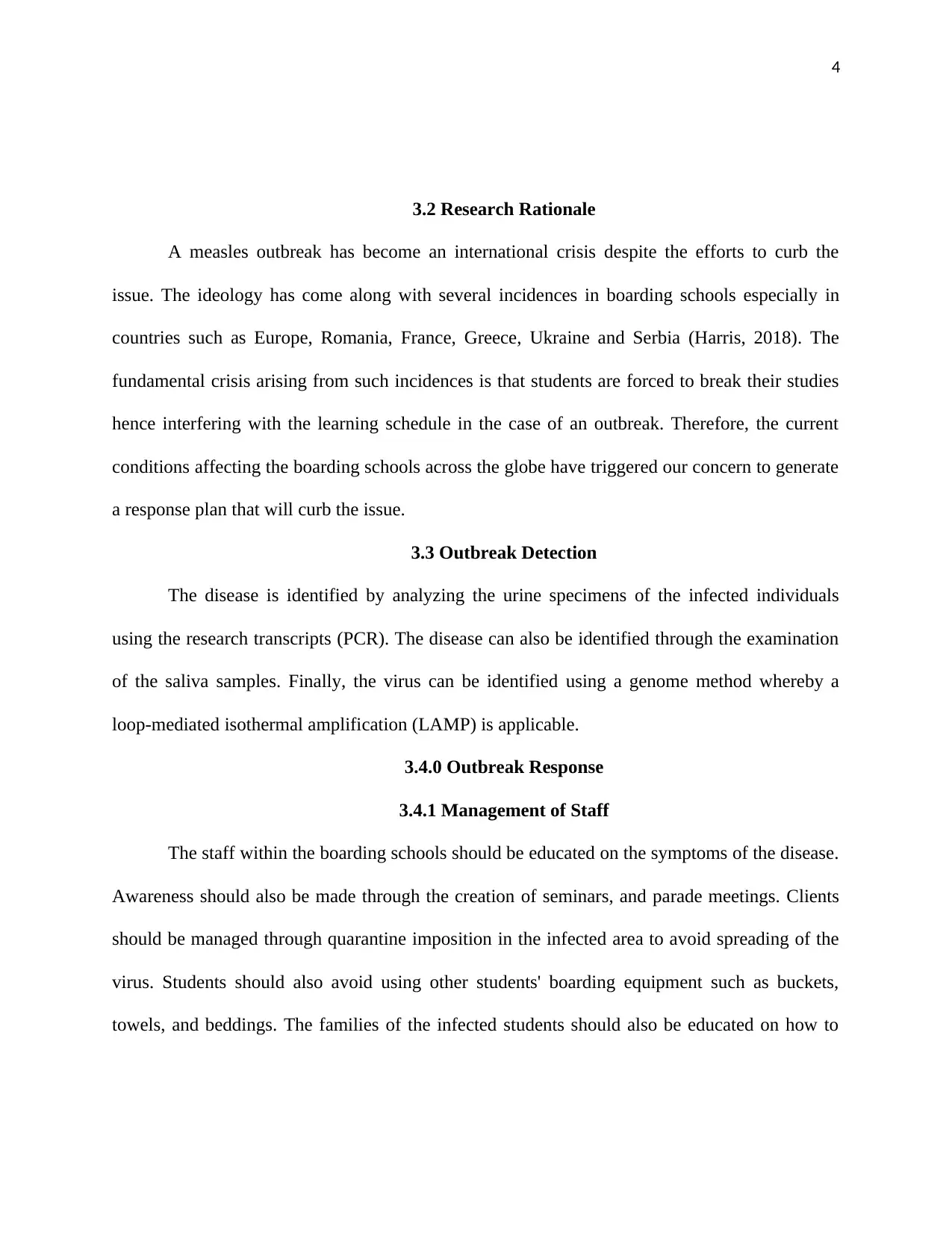
4
3.2 Research Rationale
A measles outbreak has become an international crisis despite the efforts to curb the
issue. The ideology has come along with several incidences in boarding schools especially in
countries such as Europe, Romania, France, Greece, Ukraine and Serbia (Harris, 2018). The
fundamental crisis arising from such incidences is that students are forced to break their studies
hence interfering with the learning schedule in the case of an outbreak. Therefore, the current
conditions affecting the boarding schools across the globe have triggered our concern to generate
a response plan that will curb the issue.
3.3 Outbreak Detection
The disease is identified by analyzing the urine specimens of the infected individuals
using the research transcripts (PCR). The disease can also be identified through the examination
of the saliva samples. Finally, the virus can be identified using a genome method whereby a
loop-mediated isothermal amplification (LAMP) is applicable.
3.4.0 Outbreak Response
3.4.1 Management of Staff
The staff within the boarding schools should be educated on the symptoms of the disease.
Awareness should also be made through the creation of seminars, and parade meetings. Clients
should be managed through quarantine imposition in the infected area to avoid spreading of the
virus. Students should also avoid using other students' boarding equipment such as buckets,
towels, and beddings. The families of the infected students should also be educated on how to
3.2 Research Rationale
A measles outbreak has become an international crisis despite the efforts to curb the
issue. The ideology has come along with several incidences in boarding schools especially in
countries such as Europe, Romania, France, Greece, Ukraine and Serbia (Harris, 2018). The
fundamental crisis arising from such incidences is that students are forced to break their studies
hence interfering with the learning schedule in the case of an outbreak. Therefore, the current
conditions affecting the boarding schools across the globe have triggered our concern to generate
a response plan that will curb the issue.
3.3 Outbreak Detection
The disease is identified by analyzing the urine specimens of the infected individuals
using the research transcripts (PCR). The disease can also be identified through the examination
of the saliva samples. Finally, the virus can be identified using a genome method whereby a
loop-mediated isothermal amplification (LAMP) is applicable.
3.4.0 Outbreak Response
3.4.1 Management of Staff
The staff within the boarding schools should be educated on the symptoms of the disease.
Awareness should also be made through the creation of seminars, and parade meetings. Clients
should be managed through quarantine imposition in the infected area to avoid spreading of the
virus. Students should also avoid using other students' boarding equipment such as buckets,
towels, and beddings. The families of the infected students should also be educated on how to
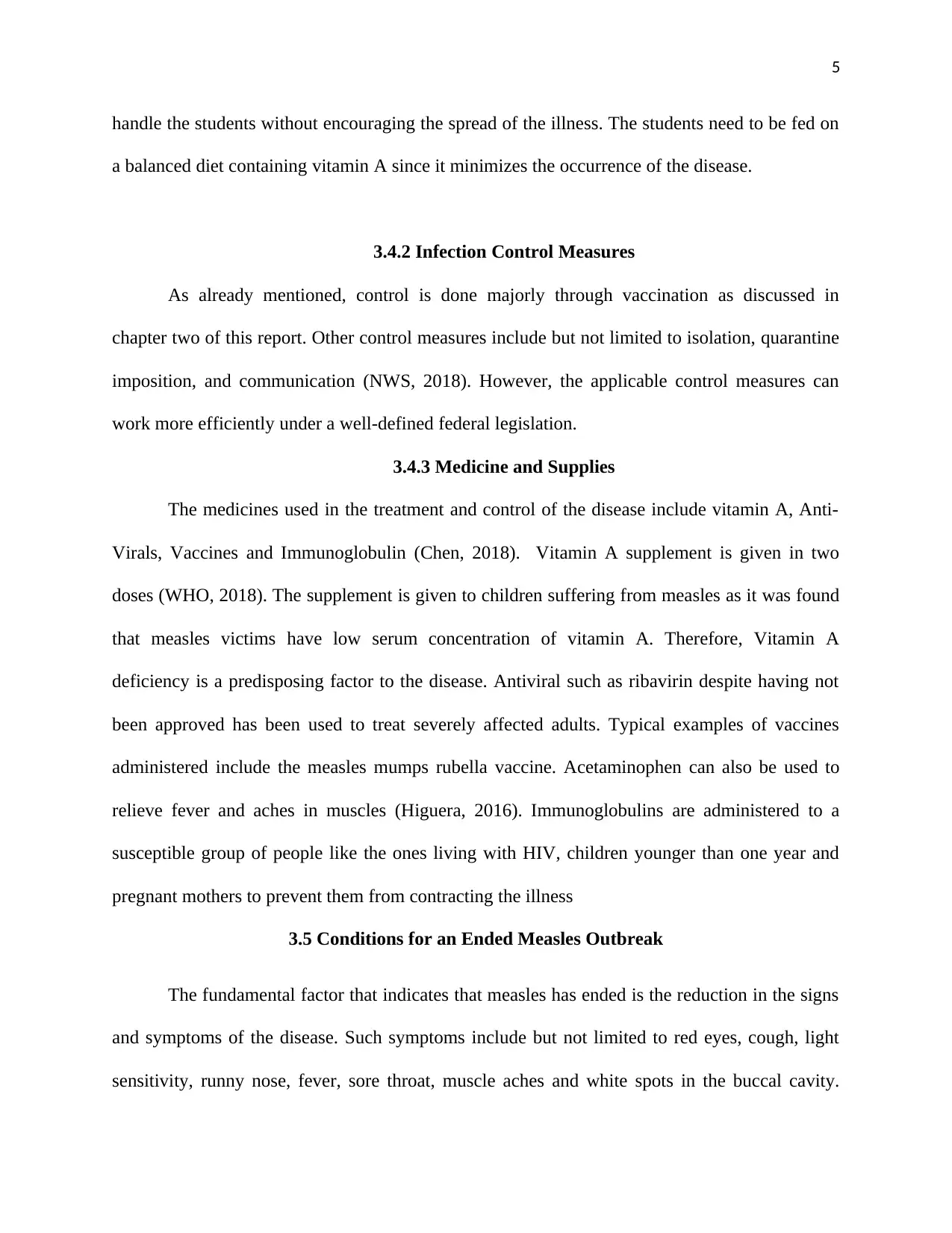
5
handle the students without encouraging the spread of the illness. The students need to be fed on
a balanced diet containing vitamin A since it minimizes the occurrence of the disease.
3.4.2 Infection Control Measures
As already mentioned, control is done majorly through vaccination as discussed in
chapter two of this report. Other control measures include but not limited to isolation, quarantine
imposition, and communication (NWS, 2018). However, the applicable control measures can
work more efficiently under a well-defined federal legislation.
3.4.3 Medicine and Supplies
The medicines used in the treatment and control of the disease include vitamin A, Anti-
Virals, Vaccines and Immunoglobulin (Chen, 2018). Vitamin A supplement is given in two
doses (WHO, 2018). The supplement is given to children suffering from measles as it was found
that measles victims have low serum concentration of vitamin A. Therefore, Vitamin A
deficiency is a predisposing factor to the disease. Antiviral such as ribavirin despite having not
been approved has been used to treat severely affected adults. Typical examples of vaccines
administered include the measles mumps rubella vaccine. Acetaminophen can also be used to
relieve fever and aches in muscles (Higuera, 2016). Immunoglobulins are administered to a
susceptible group of people like the ones living with HIV, children younger than one year and
pregnant mothers to prevent them from contracting the illness
3.5 Conditions for an Ended Measles Outbreak
The fundamental factor that indicates that measles has ended is the reduction in the signs
and symptoms of the disease. Such symptoms include but not limited to red eyes, cough, light
sensitivity, runny nose, fever, sore throat, muscle aches and white spots in the buccal cavity.
handle the students without encouraging the spread of the illness. The students need to be fed on
a balanced diet containing vitamin A since it minimizes the occurrence of the disease.
3.4.2 Infection Control Measures
As already mentioned, control is done majorly through vaccination as discussed in
chapter two of this report. Other control measures include but not limited to isolation, quarantine
imposition, and communication (NWS, 2018). However, the applicable control measures can
work more efficiently under a well-defined federal legislation.
3.4.3 Medicine and Supplies
The medicines used in the treatment and control of the disease include vitamin A, Anti-
Virals, Vaccines and Immunoglobulin (Chen, 2018). Vitamin A supplement is given in two
doses (WHO, 2018). The supplement is given to children suffering from measles as it was found
that measles victims have low serum concentration of vitamin A. Therefore, Vitamin A
deficiency is a predisposing factor to the disease. Antiviral such as ribavirin despite having not
been approved has been used to treat severely affected adults. Typical examples of vaccines
administered include the measles mumps rubella vaccine. Acetaminophen can also be used to
relieve fever and aches in muscles (Higuera, 2016). Immunoglobulins are administered to a
susceptible group of people like the ones living with HIV, children younger than one year and
pregnant mothers to prevent them from contracting the illness
3.5 Conditions for an Ended Measles Outbreak
The fundamental factor that indicates that measles has ended is the reduction in the signs
and symptoms of the disease. Such symptoms include but not limited to red eyes, cough, light
sensitivity, runny nose, fever, sore throat, muscle aches and white spots in the buccal cavity.
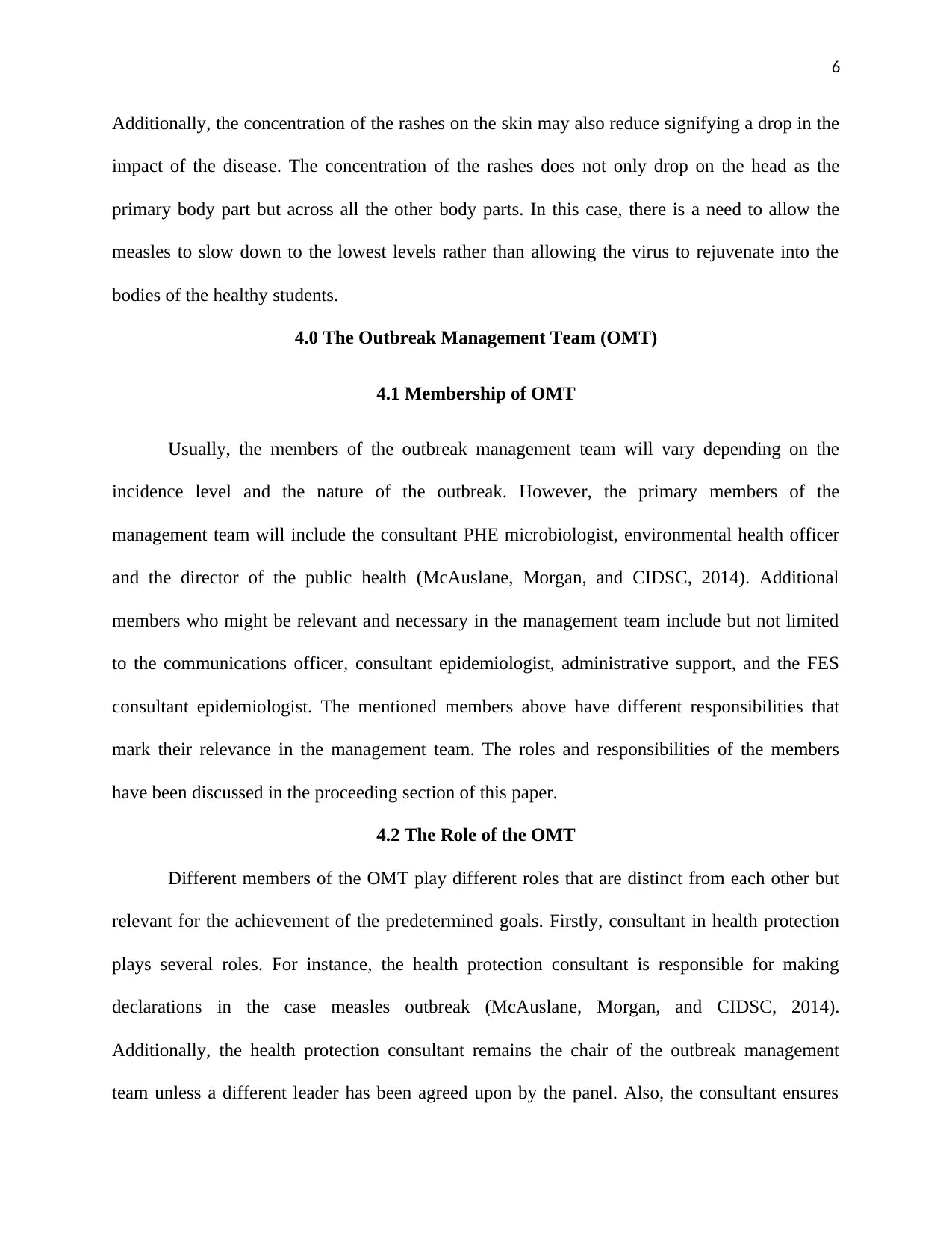
6
Additionally, the concentration of the rashes on the skin may also reduce signifying a drop in the
impact of the disease. The concentration of the rashes does not only drop on the head as the
primary body part but across all the other body parts. In this case, there is a need to allow the
measles to slow down to the lowest levels rather than allowing the virus to rejuvenate into the
bodies of the healthy students.
4.0 The Outbreak Management Team (OMT)
4.1 Membership of OMT
Usually, the members of the outbreak management team will vary depending on the
incidence level and the nature of the outbreak. However, the primary members of the
management team will include the consultant PHE microbiologist, environmental health officer
and the director of the public health (McAuslane, Morgan, and CIDSC, 2014). Additional
members who might be relevant and necessary in the management team include but not limited
to the communications officer, consultant epidemiologist, administrative support, and the FES
consultant epidemiologist. The mentioned members above have different responsibilities that
mark their relevance in the management team. The roles and responsibilities of the members
have been discussed in the proceeding section of this paper.
4.2 The Role of the OMT
Different members of the OMT play different roles that are distinct from each other but
relevant for the achievement of the predetermined goals. Firstly, consultant in health protection
plays several roles. For instance, the health protection consultant is responsible for making
declarations in the case measles outbreak (McAuslane, Morgan, and CIDSC, 2014).
Additionally, the health protection consultant remains the chair of the outbreak management
team unless a different leader has been agreed upon by the panel. Also, the consultant ensures
Additionally, the concentration of the rashes on the skin may also reduce signifying a drop in the
impact of the disease. The concentration of the rashes does not only drop on the head as the
primary body part but across all the other body parts. In this case, there is a need to allow the
measles to slow down to the lowest levels rather than allowing the virus to rejuvenate into the
bodies of the healthy students.
4.0 The Outbreak Management Team (OMT)
4.1 Membership of OMT
Usually, the members of the outbreak management team will vary depending on the
incidence level and the nature of the outbreak. However, the primary members of the
management team will include the consultant PHE microbiologist, environmental health officer
and the director of the public health (McAuslane, Morgan, and CIDSC, 2014). Additional
members who might be relevant and necessary in the management team include but not limited
to the communications officer, consultant epidemiologist, administrative support, and the FES
consultant epidemiologist. The mentioned members above have different responsibilities that
mark their relevance in the management team. The roles and responsibilities of the members
have been discussed in the proceeding section of this paper.
4.2 The Role of the OMT
Different members of the OMT play different roles that are distinct from each other but
relevant for the achievement of the predetermined goals. Firstly, consultant in health protection
plays several roles. For instance, the health protection consultant is responsible for making
declarations in the case measles outbreak (McAuslane, Morgan, and CIDSC, 2014).
Additionally, the health protection consultant remains the chair of the outbreak management
team unless a different leader has been agreed upon by the panel. Also, the consultant ensures
Paraphrase This Document
Need a fresh take? Get an instant paraphrase of this document with our AI Paraphraser
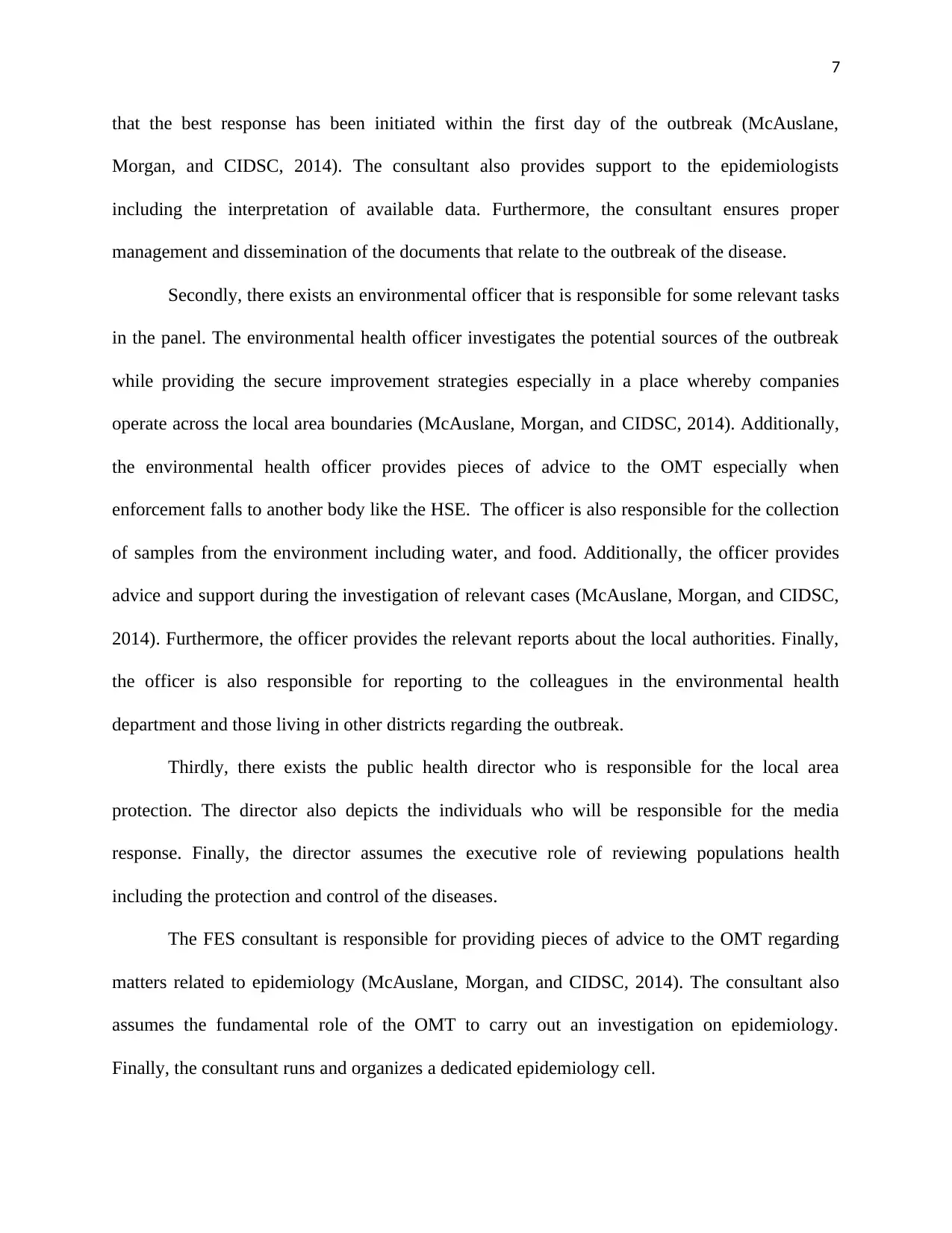
7
that the best response has been initiated within the first day of the outbreak (McAuslane,
Morgan, and CIDSC, 2014). The consultant also provides support to the epidemiologists
including the interpretation of available data. Furthermore, the consultant ensures proper
management and dissemination of the documents that relate to the outbreak of the disease.
Secondly, there exists an environmental officer that is responsible for some relevant tasks
in the panel. The environmental health officer investigates the potential sources of the outbreak
while providing the secure improvement strategies especially in a place whereby companies
operate across the local area boundaries (McAuslane, Morgan, and CIDSC, 2014). Additionally,
the environmental health officer provides pieces of advice to the OMT especially when
enforcement falls to another body like the HSE. The officer is also responsible for the collection
of samples from the environment including water, and food. Additionally, the officer provides
advice and support during the investigation of relevant cases (McAuslane, Morgan, and CIDSC,
2014). Furthermore, the officer provides the relevant reports about the local authorities. Finally,
the officer is also responsible for reporting to the colleagues in the environmental health
department and those living in other districts regarding the outbreak.
Thirdly, there exists the public health director who is responsible for the local area
protection. The director also depicts the individuals who will be responsible for the media
response. Finally, the director assumes the executive role of reviewing populations health
including the protection and control of the diseases.
The FES consultant is responsible for providing pieces of advice to the OMT regarding
matters related to epidemiology (McAuslane, Morgan, and CIDSC, 2014). The consultant also
assumes the fundamental role of the OMT to carry out an investigation on epidemiology.
Finally, the consultant runs and organizes a dedicated epidemiology cell.
that the best response has been initiated within the first day of the outbreak (McAuslane,
Morgan, and CIDSC, 2014). The consultant also provides support to the epidemiologists
including the interpretation of available data. Furthermore, the consultant ensures proper
management and dissemination of the documents that relate to the outbreak of the disease.
Secondly, there exists an environmental officer that is responsible for some relevant tasks
in the panel. The environmental health officer investigates the potential sources of the outbreak
while providing the secure improvement strategies especially in a place whereby companies
operate across the local area boundaries (McAuslane, Morgan, and CIDSC, 2014). Additionally,
the environmental health officer provides pieces of advice to the OMT especially when
enforcement falls to another body like the HSE. The officer is also responsible for the collection
of samples from the environment including water, and food. Additionally, the officer provides
advice and support during the investigation of relevant cases (McAuslane, Morgan, and CIDSC,
2014). Furthermore, the officer provides the relevant reports about the local authorities. Finally,
the officer is also responsible for reporting to the colleagues in the environmental health
department and those living in other districts regarding the outbreak.
Thirdly, there exists the public health director who is responsible for the local area
protection. The director also depicts the individuals who will be responsible for the media
response. Finally, the director assumes the executive role of reviewing populations health
including the protection and control of the diseases.
The FES consultant is responsible for providing pieces of advice to the OMT regarding
matters related to epidemiology (McAuslane, Morgan, and CIDSC, 2014). The consultant also
assumes the fundamental role of the OMT to carry out an investigation on epidemiology.
Finally, the consultant runs and organizes a dedicated epidemiology cell.
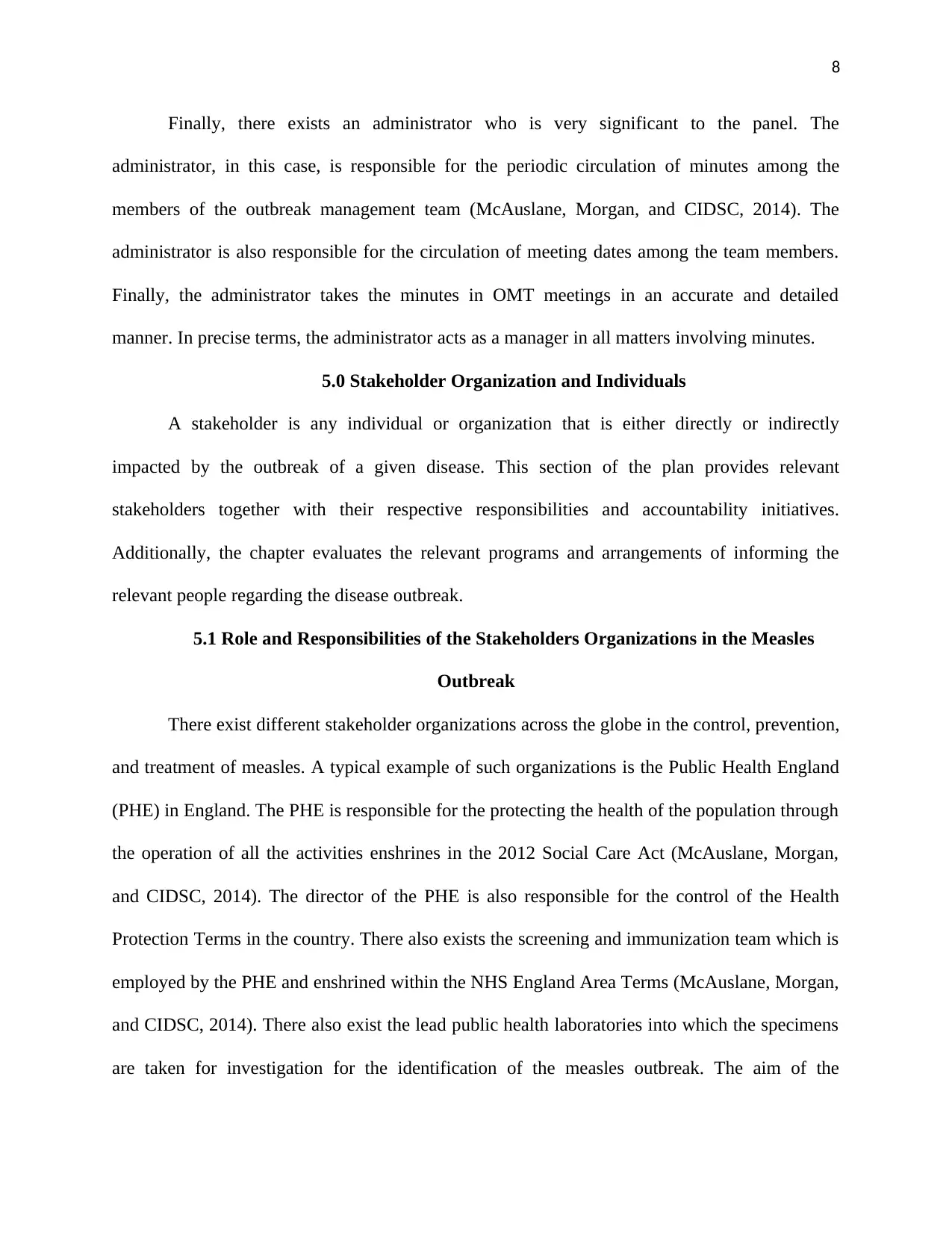
8
Finally, there exists an administrator who is very significant to the panel. The
administrator, in this case, is responsible for the periodic circulation of minutes among the
members of the outbreak management team (McAuslane, Morgan, and CIDSC, 2014). The
administrator is also responsible for the circulation of meeting dates among the team members.
Finally, the administrator takes the minutes in OMT meetings in an accurate and detailed
manner. In precise terms, the administrator acts as a manager in all matters involving minutes.
5.0 Stakeholder Organization and Individuals
A stakeholder is any individual or organization that is either directly or indirectly
impacted by the outbreak of a given disease. This section of the plan provides relevant
stakeholders together with their respective responsibilities and accountability initiatives.
Additionally, the chapter evaluates the relevant programs and arrangements of informing the
relevant people regarding the disease outbreak.
5.1 Role and Responsibilities of the Stakeholders Organizations in the Measles
Outbreak
There exist different stakeholder organizations across the globe in the control, prevention,
and treatment of measles. A typical example of such organizations is the Public Health England
(PHE) in England. The PHE is responsible for the protecting the health of the population through
the operation of all the activities enshrines in the 2012 Social Care Act (McAuslane, Morgan,
and CIDSC, 2014). The director of the PHE is also responsible for the control of the Health
Protection Terms in the country. There also exists the screening and immunization team which is
employed by the PHE and enshrined within the NHS England Area Terms (McAuslane, Morgan,
and CIDSC, 2014). There also exist the lead public health laboratories into which the specimens
are taken for investigation for the identification of the measles outbreak. The aim of the
Finally, there exists an administrator who is very significant to the panel. The
administrator, in this case, is responsible for the periodic circulation of minutes among the
members of the outbreak management team (McAuslane, Morgan, and CIDSC, 2014). The
administrator is also responsible for the circulation of meeting dates among the team members.
Finally, the administrator takes the minutes in OMT meetings in an accurate and detailed
manner. In precise terms, the administrator acts as a manager in all matters involving minutes.
5.0 Stakeholder Organization and Individuals
A stakeholder is any individual or organization that is either directly or indirectly
impacted by the outbreak of a given disease. This section of the plan provides relevant
stakeholders together with their respective responsibilities and accountability initiatives.
Additionally, the chapter evaluates the relevant programs and arrangements of informing the
relevant people regarding the disease outbreak.
5.1 Role and Responsibilities of the Stakeholders Organizations in the Measles
Outbreak
There exist different stakeholder organizations across the globe in the control, prevention,
and treatment of measles. A typical example of such organizations is the Public Health England
(PHE) in England. The PHE is responsible for the protecting the health of the population through
the operation of all the activities enshrines in the 2012 Social Care Act (McAuslane, Morgan,
and CIDSC, 2014). The director of the PHE is also responsible for the control of the Health
Protection Terms in the country. There also exists the screening and immunization team which is
employed by the PHE and enshrined within the NHS England Area Terms (McAuslane, Morgan,
and CIDSC, 2014). There also exist the lead public health laboratories into which the specimens
are taken for investigation for the identification of the measles outbreak. The aim of the
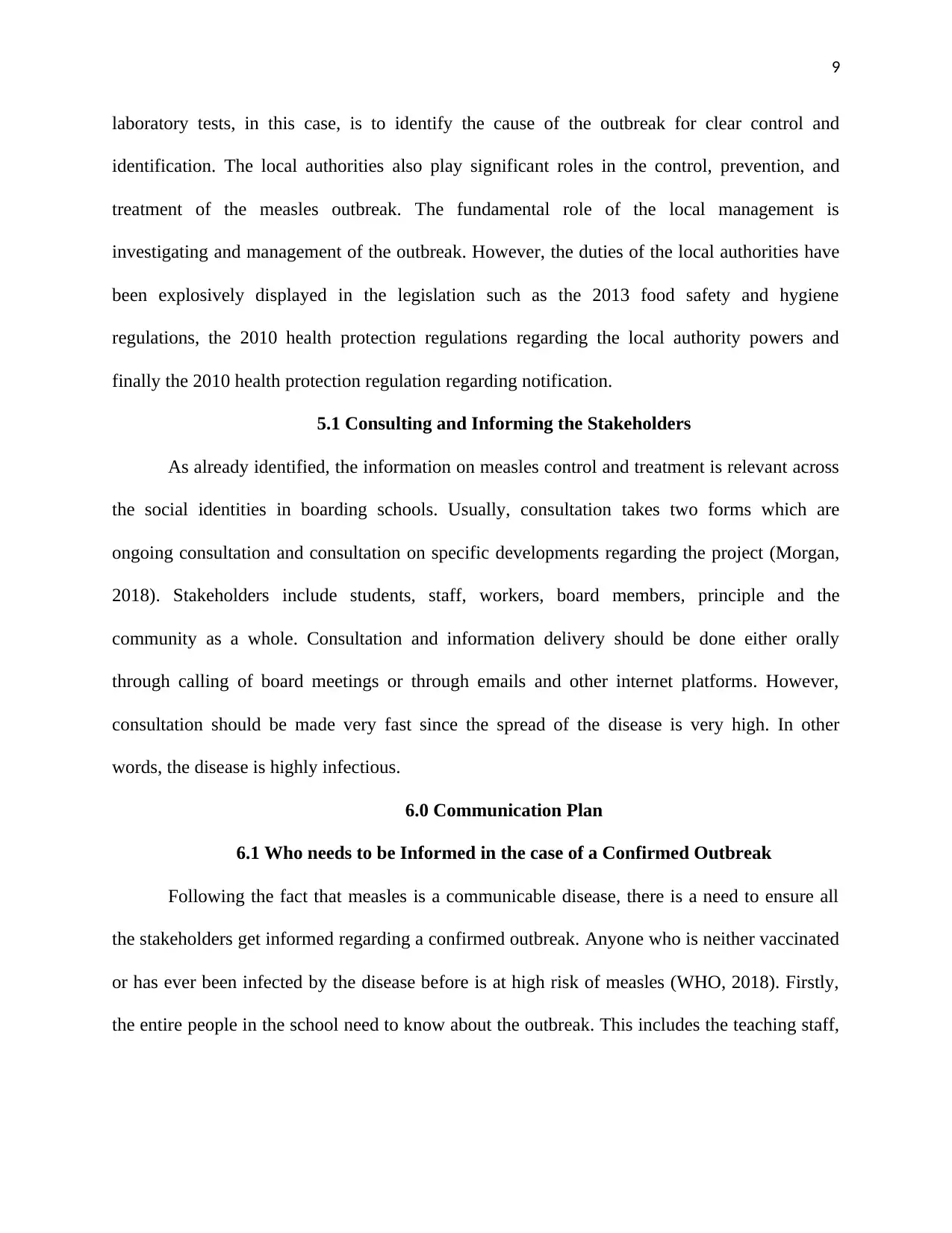
9
laboratory tests, in this case, is to identify the cause of the outbreak for clear control and
identification. The local authorities also play significant roles in the control, prevention, and
treatment of the measles outbreak. The fundamental role of the local management is
investigating and management of the outbreak. However, the duties of the local authorities have
been explosively displayed in the legislation such as the 2013 food safety and hygiene
regulations, the 2010 health protection regulations regarding the local authority powers and
finally the 2010 health protection regulation regarding notification.
5.1 Consulting and Informing the Stakeholders
As already identified, the information on measles control and treatment is relevant across
the social identities in boarding schools. Usually, consultation takes two forms which are
ongoing consultation and consultation on specific developments regarding the project (Morgan,
2018). Stakeholders include students, staff, workers, board members, principle and the
community as a whole. Consultation and information delivery should be done either orally
through calling of board meetings or through emails and other internet platforms. However,
consultation should be made very fast since the spread of the disease is very high. In other
words, the disease is highly infectious.
6.0 Communication Plan
6.1 Who needs to be Informed in the case of a Confirmed Outbreak
Following the fact that measles is a communicable disease, there is a need to ensure all
the stakeholders get informed regarding a confirmed outbreak. Anyone who is neither vaccinated
or has ever been infected by the disease before is at high risk of measles (WHO, 2018). Firstly,
the entire people in the school need to know about the outbreak. This includes the teaching staff,
laboratory tests, in this case, is to identify the cause of the outbreak for clear control and
identification. The local authorities also play significant roles in the control, prevention, and
treatment of the measles outbreak. The fundamental role of the local management is
investigating and management of the outbreak. However, the duties of the local authorities have
been explosively displayed in the legislation such as the 2013 food safety and hygiene
regulations, the 2010 health protection regulations regarding the local authority powers and
finally the 2010 health protection regulation regarding notification.
5.1 Consulting and Informing the Stakeholders
As already identified, the information on measles control and treatment is relevant across
the social identities in boarding schools. Usually, consultation takes two forms which are
ongoing consultation and consultation on specific developments regarding the project (Morgan,
2018). Stakeholders include students, staff, workers, board members, principle and the
community as a whole. Consultation and information delivery should be done either orally
through calling of board meetings or through emails and other internet platforms. However,
consultation should be made very fast since the spread of the disease is very high. In other
words, the disease is highly infectious.
6.0 Communication Plan
6.1 Who needs to be Informed in the case of a Confirmed Outbreak
Following the fact that measles is a communicable disease, there is a need to ensure all
the stakeholders get informed regarding a confirmed outbreak. Anyone who is neither vaccinated
or has ever been infected by the disease before is at high risk of measles (WHO, 2018). Firstly,
the entire people in the school need to know about the outbreak. This includes the teaching staff,
Secure Best Marks with AI Grader
Need help grading? Try our AI Grader for instant feedback on your assignments.
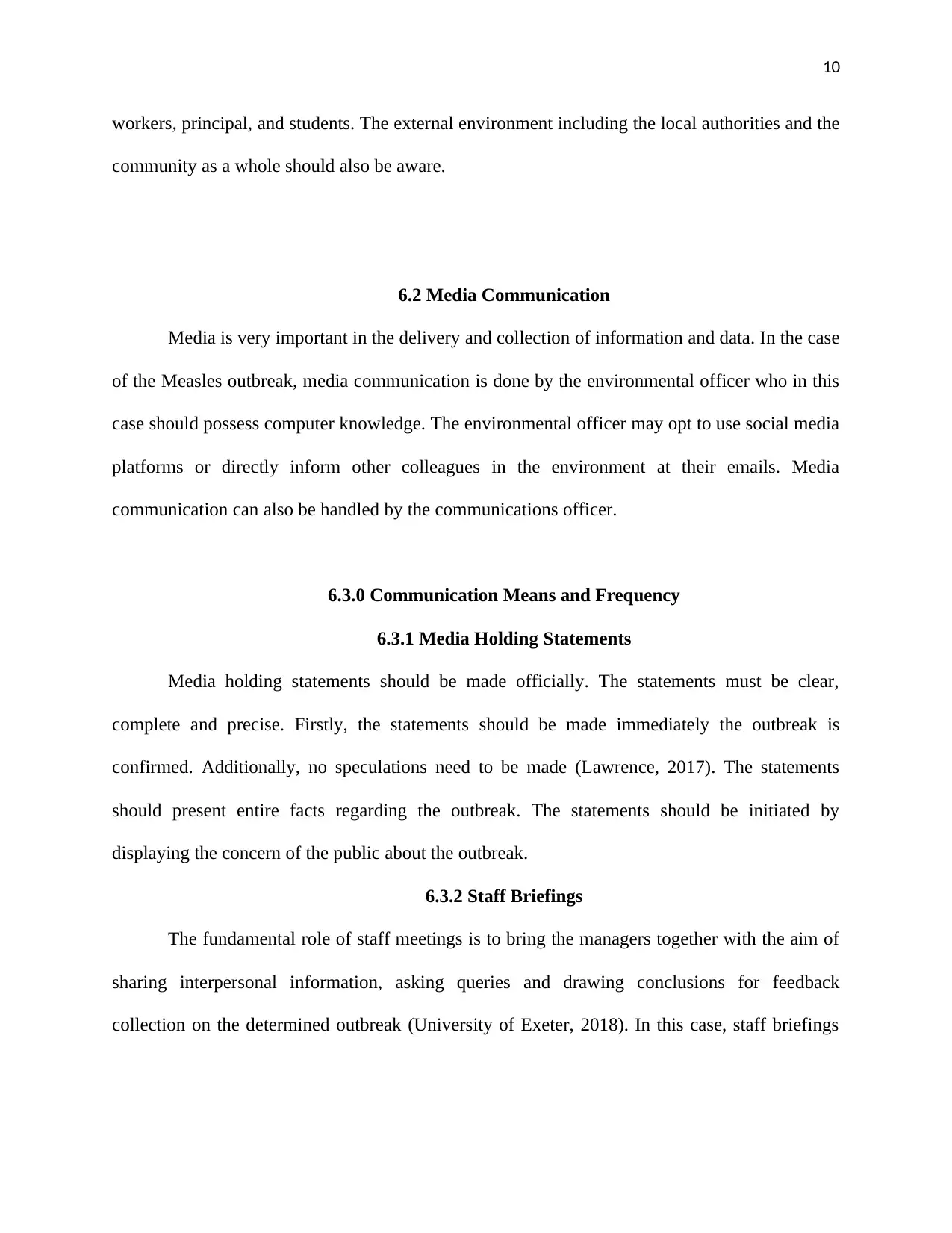
10
workers, principal, and students. The external environment including the local authorities and the
community as a whole should also be aware.
6.2 Media Communication
Media is very important in the delivery and collection of information and data. In the case
of the Measles outbreak, media communication is done by the environmental officer who in this
case should possess computer knowledge. The environmental officer may opt to use social media
platforms or directly inform other colleagues in the environment at their emails. Media
communication can also be handled by the communications officer.
6.3.0 Communication Means and Frequency
6.3.1 Media Holding Statements
Media holding statements should be made officially. The statements must be clear,
complete and precise. Firstly, the statements should be made immediately the outbreak is
confirmed. Additionally, no speculations need to be made (Lawrence, 2017). The statements
should present entire facts regarding the outbreak. The statements should be initiated by
displaying the concern of the public about the outbreak.
6.3.2 Staff Briefings
The fundamental role of staff meetings is to bring the managers together with the aim of
sharing interpersonal information, asking queries and drawing conclusions for feedback
collection on the determined outbreak (University of Exeter, 2018). In this case, staff briefings
workers, principal, and students. The external environment including the local authorities and the
community as a whole should also be aware.
6.2 Media Communication
Media is very important in the delivery and collection of information and data. In the case
of the Measles outbreak, media communication is done by the environmental officer who in this
case should possess computer knowledge. The environmental officer may opt to use social media
platforms or directly inform other colleagues in the environment at their emails. Media
communication can also be handled by the communications officer.
6.3.0 Communication Means and Frequency
6.3.1 Media Holding Statements
Media holding statements should be made officially. The statements must be clear,
complete and precise. Firstly, the statements should be made immediately the outbreak is
confirmed. Additionally, no speculations need to be made (Lawrence, 2017). The statements
should present entire facts regarding the outbreak. The statements should be initiated by
displaying the concern of the public about the outbreak.
6.3.2 Staff Briefings
The fundamental role of staff meetings is to bring the managers together with the aim of
sharing interpersonal information, asking queries and drawing conclusions for feedback
collection on the determined outbreak (University of Exeter, 2018). In this case, staff briefings
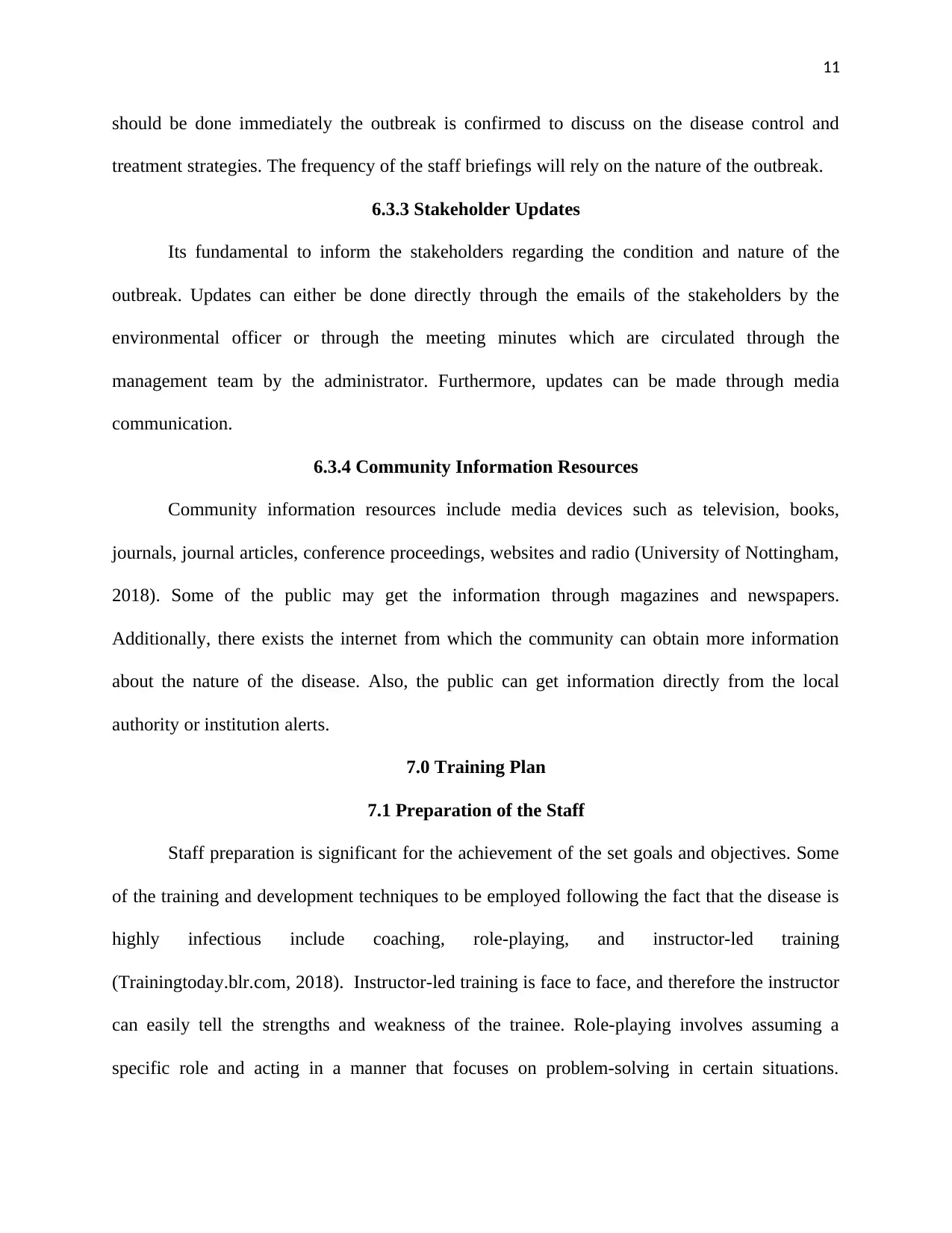
11
should be done immediately the outbreak is confirmed to discuss on the disease control and
treatment strategies. The frequency of the staff briefings will rely on the nature of the outbreak.
6.3.3 Stakeholder Updates
Its fundamental to inform the stakeholders regarding the condition and nature of the
outbreak. Updates can either be done directly through the emails of the stakeholders by the
environmental officer or through the meeting minutes which are circulated through the
management team by the administrator. Furthermore, updates can be made through media
communication.
6.3.4 Community Information Resources
Community information resources include media devices such as television, books,
journals, journal articles, conference proceedings, websites and radio (University of Nottingham,
2018). Some of the public may get the information through magazines and newspapers.
Additionally, there exists the internet from which the community can obtain more information
about the nature of the disease. Also, the public can get information directly from the local
authority or institution alerts.
7.0 Training Plan
7.1 Preparation of the Staff
Staff preparation is significant for the achievement of the set goals and objectives. Some
of the training and development techniques to be employed following the fact that the disease is
highly infectious include coaching, role-playing, and instructor-led training
(Trainingtoday.blr.com, 2018). Instructor-led training is face to face, and therefore the instructor
can easily tell the strengths and weakness of the trainee. Role-playing involves assuming a
specific role and acting in a manner that focuses on problem-solving in certain situations.
should be done immediately the outbreak is confirmed to discuss on the disease control and
treatment strategies. The frequency of the staff briefings will rely on the nature of the outbreak.
6.3.3 Stakeholder Updates
Its fundamental to inform the stakeholders regarding the condition and nature of the
outbreak. Updates can either be done directly through the emails of the stakeholders by the
environmental officer or through the meeting minutes which are circulated through the
management team by the administrator. Furthermore, updates can be made through media
communication.
6.3.4 Community Information Resources
Community information resources include media devices such as television, books,
journals, journal articles, conference proceedings, websites and radio (University of Nottingham,
2018). Some of the public may get the information through magazines and newspapers.
Additionally, there exists the internet from which the community can obtain more information
about the nature of the disease. Also, the public can get information directly from the local
authority or institution alerts.
7.0 Training Plan
7.1 Preparation of the Staff
Staff preparation is significant for the achievement of the set goals and objectives. Some
of the training and development techniques to be employed following the fact that the disease is
highly infectious include coaching, role-playing, and instructor-led training
(Trainingtoday.blr.com, 2018). Instructor-led training is face to face, and therefore the instructor
can easily tell the strengths and weakness of the trainee. Role-playing involves assuming a
specific role and acting in a manner that focuses on problem-solving in certain situations.
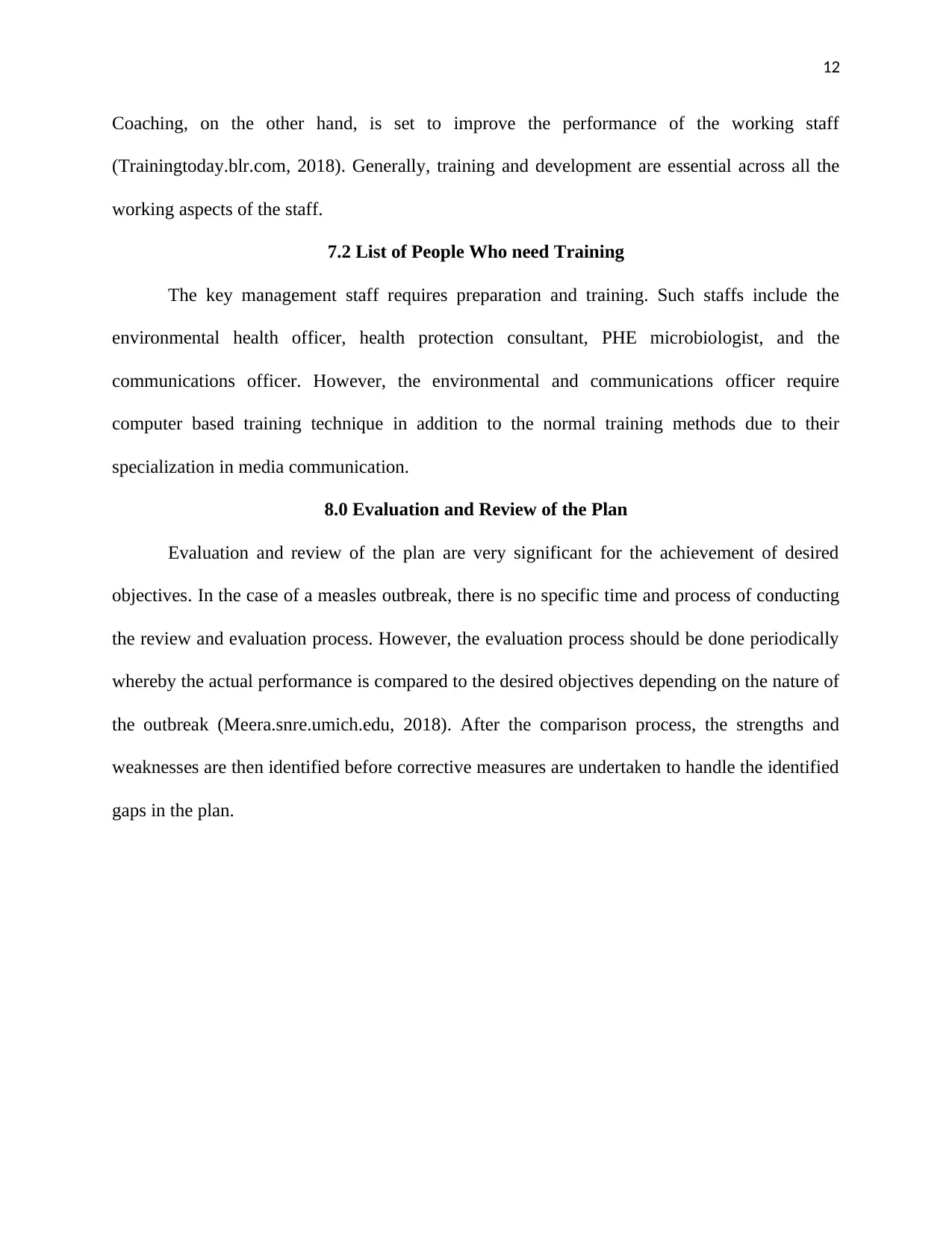
12
Coaching, on the other hand, is set to improve the performance of the working staff
(Trainingtoday.blr.com, 2018). Generally, training and development are essential across all the
working aspects of the staff.
7.2 List of People Who need Training
The key management staff requires preparation and training. Such staffs include the
environmental health officer, health protection consultant, PHE microbiologist, and the
communications officer. However, the environmental and communications officer require
computer based training technique in addition to the normal training methods due to their
specialization in media communication.
8.0 Evaluation and Review of the Plan
Evaluation and review of the plan are very significant for the achievement of desired
objectives. In the case of a measles outbreak, there is no specific time and process of conducting
the review and evaluation process. However, the evaluation process should be done periodically
whereby the actual performance is compared to the desired objectives depending on the nature of
the outbreak (Meera.snre.umich.edu, 2018). After the comparison process, the strengths and
weaknesses are then identified before corrective measures are undertaken to handle the identified
gaps in the plan.
Coaching, on the other hand, is set to improve the performance of the working staff
(Trainingtoday.blr.com, 2018). Generally, training and development are essential across all the
working aspects of the staff.
7.2 List of People Who need Training
The key management staff requires preparation and training. Such staffs include the
environmental health officer, health protection consultant, PHE microbiologist, and the
communications officer. However, the environmental and communications officer require
computer based training technique in addition to the normal training methods due to their
specialization in media communication.
8.0 Evaluation and Review of the Plan
Evaluation and review of the plan are very significant for the achievement of desired
objectives. In the case of a measles outbreak, there is no specific time and process of conducting
the review and evaluation process. However, the evaluation process should be done periodically
whereby the actual performance is compared to the desired objectives depending on the nature of
the outbreak (Meera.snre.umich.edu, 2018). After the comparison process, the strengths and
weaknesses are then identified before corrective measures are undertaken to handle the identified
gaps in the plan.
Paraphrase This Document
Need a fresh take? Get an instant paraphrase of this document with our AI Paraphraser
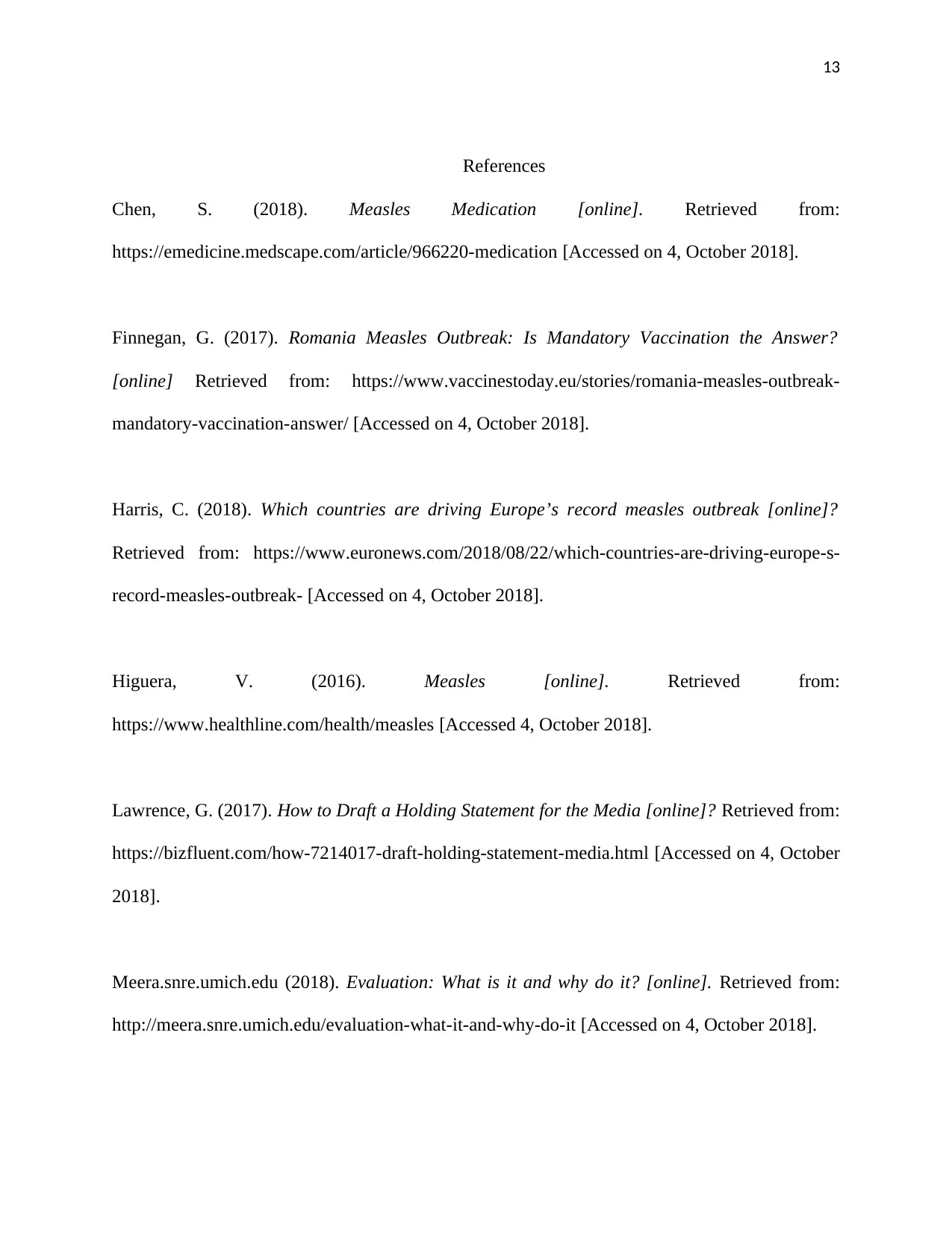
13
References
Chen, S. (2018). Measles Medication [online]. Retrieved from:
https://emedicine.medscape.com/article/966220-medication [Accessed on 4, October 2018].
Finnegan, G. (2017). Romania Measles Outbreak: Is Mandatory Vaccination the Answer?
[online] Retrieved from: https://www.vaccinestoday.eu/stories/romania-measles-outbreak-
mandatory-vaccination-answer/ [Accessed on 4, October 2018].
Harris, C. (2018). Which countries are driving Europe’s record measles outbreak [online]?
Retrieved from: https://www.euronews.com/2018/08/22/which-countries-are-driving-europe-s-
record-measles-outbreak- [Accessed on 4, October 2018].
Higuera, V. (2016). Measles [online]. Retrieved from:
https://www.healthline.com/health/measles [Accessed 4, October 2018].
Lawrence, G. (2017). How to Draft a Holding Statement for the Media [online]? Retrieved from:
https://bizfluent.com/how-7214017-draft-holding-statement-media.html [Accessed on 4, October
2018].
Meera.snre.umich.edu (2018). Evaluation: What is it and why do it? [online]. Retrieved from:
http://meera.snre.umich.edu/evaluation-what-it-and-why-do-it [Accessed on 4, October 2018].
References
Chen, S. (2018). Measles Medication [online]. Retrieved from:
https://emedicine.medscape.com/article/966220-medication [Accessed on 4, October 2018].
Finnegan, G. (2017). Romania Measles Outbreak: Is Mandatory Vaccination the Answer?
[online] Retrieved from: https://www.vaccinestoday.eu/stories/romania-measles-outbreak-
mandatory-vaccination-answer/ [Accessed on 4, October 2018].
Harris, C. (2018). Which countries are driving Europe’s record measles outbreak [online]?
Retrieved from: https://www.euronews.com/2018/08/22/which-countries-are-driving-europe-s-
record-measles-outbreak- [Accessed on 4, October 2018].
Higuera, V. (2016). Measles [online]. Retrieved from:
https://www.healthline.com/health/measles [Accessed 4, October 2018].
Lawrence, G. (2017). How to Draft a Holding Statement for the Media [online]? Retrieved from:
https://bizfluent.com/how-7214017-draft-holding-statement-media.html [Accessed on 4, October
2018].
Meera.snre.umich.edu (2018). Evaluation: What is it and why do it? [online]. Retrieved from:
http://meera.snre.umich.edu/evaluation-what-it-and-why-do-it [Accessed on 4, October 2018].

14
McAuslane, H., Morgan, D., and CIDSC (2014). Communicable Disease Outbreak Management
[online]. Retrieved from: https://assets.publishing.service.gov.uk/government/uploads/system/
uploads/attachment_data/file/
343723/12_8_2014_CD_Outbreak_Guidance_REandCT_2__2_.pdf [Accessed on 4, October
2018].
Morgan C. (2018). Stakeholder Research and Consultation: Keep Your Ears to the Ground
[online]. Retrieved from: https://www.b2binternational.com/publications/stakeholder-research/
[Accessed on 4, October 2018].
NWS (2018). Measles Control Guideline [online]. Retrieved from:
https://www.health.nsw.gov.au/Infectious/controlguideline/Pages/measles.aspx [Accessed on 4,
October 2028].
Parry, L. (2018). A measles outbreak at school infects 15 students-with health officials warning
all parents to be on high alert [online]. Retrieved from:
https://www.thesun.co.uk/news/6344217/measles-outbreak-chichester-high-school-infects-15-
students-public-health-england-parents-warning/ [Accessed on 4, October 2018].
Smith K. (2018). Preventing, identifying and managing the measles outbreak [online]. Retrieved
from: https://www.nursingtimes.net/clinical-archive/infection-control/preventing-identifying-
and-managing-measles-outbreaks/7025742.article [Accessed on 4, October 2018].
McAuslane, H., Morgan, D., and CIDSC (2014). Communicable Disease Outbreak Management
[online]. Retrieved from: https://assets.publishing.service.gov.uk/government/uploads/system/
uploads/attachment_data/file/
343723/12_8_2014_CD_Outbreak_Guidance_REandCT_2__2_.pdf [Accessed on 4, October
2018].
Morgan C. (2018). Stakeholder Research and Consultation: Keep Your Ears to the Ground
[online]. Retrieved from: https://www.b2binternational.com/publications/stakeholder-research/
[Accessed on 4, October 2018].
NWS (2018). Measles Control Guideline [online]. Retrieved from:
https://www.health.nsw.gov.au/Infectious/controlguideline/Pages/measles.aspx [Accessed on 4,
October 2028].
Parry, L. (2018). A measles outbreak at school infects 15 students-with health officials warning
all parents to be on high alert [online]. Retrieved from:
https://www.thesun.co.uk/news/6344217/measles-outbreak-chichester-high-school-infects-15-
students-public-health-england-parents-warning/ [Accessed on 4, October 2018].
Smith K. (2018). Preventing, identifying and managing the measles outbreak [online]. Retrieved
from: https://www.nursingtimes.net/clinical-archive/infection-control/preventing-identifying-
and-managing-measles-outbreaks/7025742.article [Accessed on 4, October 2018].
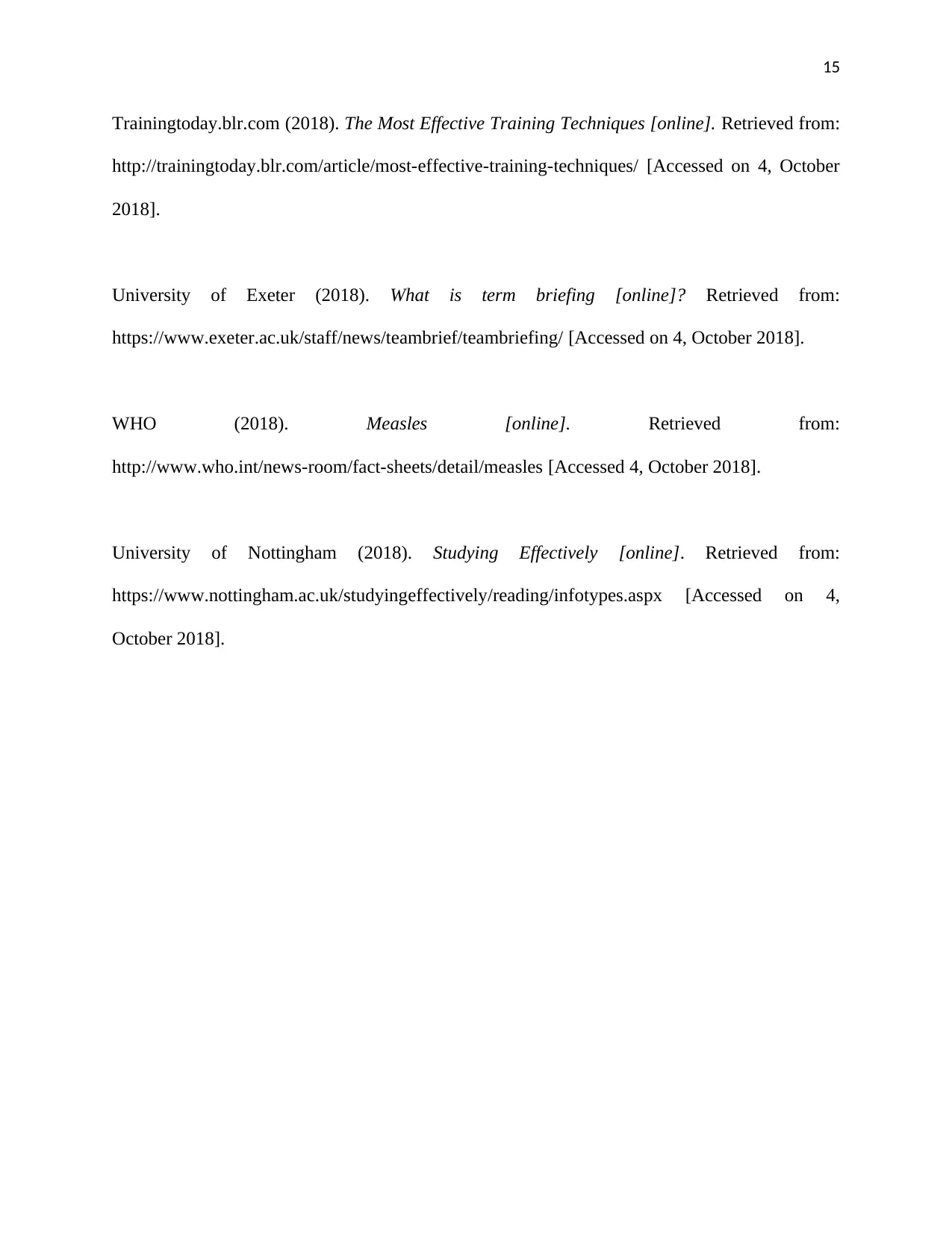
15
Trainingtoday.blr.com (2018). The Most Effective Training Techniques [online]. Retrieved from:
http://trainingtoday.blr.com/article/most-effective-training-techniques/ [Accessed on 4, October
2018].
University of Exeter (2018). What is term briefing [online]? Retrieved from:
https://www.exeter.ac.uk/staff/news/teambrief/teambriefing/ [Accessed on 4, October 2018].
WHO (2018). Measles [online]. Retrieved from:
http://www.who.int/news-room/fact-sheets/detail/measles [Accessed 4, October 2018].
University of Nottingham (2018). Studying Effectively [online]. Retrieved from:
https://www.nottingham.ac.uk/studyingeffectively/reading/infotypes.aspx [Accessed on 4,
October 2018].
Trainingtoday.blr.com (2018). The Most Effective Training Techniques [online]. Retrieved from:
http://trainingtoday.blr.com/article/most-effective-training-techniques/ [Accessed on 4, October
2018].
University of Exeter (2018). What is term briefing [online]? Retrieved from:
https://www.exeter.ac.uk/staff/news/teambrief/teambriefing/ [Accessed on 4, October 2018].
WHO (2018). Measles [online]. Retrieved from:
http://www.who.int/news-room/fact-sheets/detail/measles [Accessed 4, October 2018].
University of Nottingham (2018). Studying Effectively [online]. Retrieved from:
https://www.nottingham.ac.uk/studyingeffectively/reading/infotypes.aspx [Accessed on 4,
October 2018].
1 out of 16
Your All-in-One AI-Powered Toolkit for Academic Success.
+13062052269
info@desklib.com
Available 24*7 on WhatsApp / Email
![[object Object]](/_next/static/media/star-bottom.7253800d.svg)
Unlock your academic potential
© 2024 | Zucol Services PVT LTD | All rights reserved.

